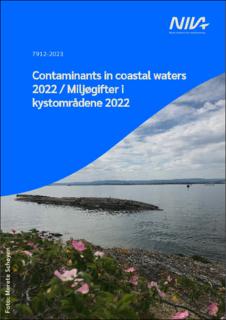Contaminants in coastal waters 2022
| dc.contributor.author | Schøyen, Merete | |
| dc.contributor.author | Grung, Merete | |
| dc.contributor.author | Lund, Espen | |
| dc.contributor.author | Hjermann, Dag Øystein | |
| dc.contributor.author | Ruus, Anders | |
| dc.contributor.author | Øxnevad, Sigurd | |
| dc.contributor.author | Christensen, Guttorm | |
| dc.contributor.author | Beylich, Bjørnar | |
| dc.contributor.author | Jenssen, Marthe Torunn Solhaug | |
| dc.contributor.author | Tveiten, Lise Ann | |
| dc.contributor.author | Håvardstun, Jarle | |
| dc.contributor.author | Eftevåg, Veronica Sæther | |
| dc.contributor.author | Bæk, Kine | |
| dc.date.accessioned | 2024-04-19T10:38:07Z | |
| dc.date.available | 2024-04-19T10:38:07Z | |
| dc.date.created | 2024-04-18T11:12:38Z | |
| dc.date.issued | 2024 | |
| dc.identifier.isbn | 978-82-577-7648-0 | |
| dc.identifier.issn | 1894-7948 | |
| dc.identifier.uri | https://hdl.handle.net/11250/3127406 | |
| dc.description | Prosjektleder: Merete Schøyen | en_US |
| dc.description.abstract | The Norwegian environmental monitoring programme “Contaminants in coastal waters” (Miljøgifter i kystområdene - MILKYS) examines the levels, trends, and effects of contaminants annually in biota along the Norwegian fjords and coastline including Svalbard. The 2022 investigation included analyses of more than 180 different contaminants or biological effect parameters in five species (blue mussel, cod, dogwhelk, common periwinkle, and common eider). The contaminants measured include metals, TBT, PCBs, PAHs, PBDEs, PFAS, HBCDs, chlorinated paraffins, siloxanes, and pesticides. Biological effect parameters investigated include imposex (VDSI) and intersex (ISI), PAH-metabolites, ALA-D, and EROD. In this report, 37 contaminants and in addition, biological effect parameters were chosen for in-depth presentation. EQSs (Environmental Quality Standards) were exceeded in blue mussel (15%) and cod (36%) expressed as datapoints (contaminants x stations). Contaminants above EQSs were mercury (Hg), sumPCB7, sumPBDE6, and MCCP. The sum of exceedances (sum of risk quotients) was highest in cod from the Inner Oslofjord. PROREFs (Norwegian provisional high reference contaminant concentrations) were exceeded in blue mussel (38%) and cod (9%) expressed as datapoints (contaminants x stations), and exceedances were higher in mussel (up to 10-20x PROREF) than cod (5-10x PROREF). The sum of PROREFratio above background levels were highest in blue mussel from Akershuskaia in the harbour of the Inner Oslofjord. Significant decreasing time trends for specific contaminants/effects dominated both long-term (> 10 years) and short-term (≤ 10 years) where trends could be detected, still some significant increasing trends were observed for contaminants exceeding EQS and/or PROREF. Notably significant increasing short-term trends were found for lead (Pb), chromium (Cr), and some PCBs in blue mussel, and for mercury, and silver (Ag) in cod. | en_US |
| dc.description.sponsorship | The Norwegian Environment Agency / Miljødirektoratet | en_US |
| dc.language.iso | eng | en_US |
| dc.publisher | Norsk institutt for vannforskning | en_US |
| dc.relation.ispartof | NIVA-rapport | |
| dc.relation.ispartofseries | NIVA-rapport;7912-2023 | |
| dc.subject | Nivåer og trender | en_US |
| dc.subject | Levels and trends | en_US |
| dc.subject | Norskekysten | en_US |
| dc.subject | Norwegian coast | en_US |
| dc.subject | Biologiske effekter | en_US |
| dc.subject | Biological effects | en_US |
| dc.subject | Miljøgifter i biota | en_US |
| dc.subject | Environmental contaminants in biota | en_US |
| dc.title | Contaminants in coastal waters 2022 | en_US |
| dc.type | Research report | en_US |
| dc.description.version | publishedVersion | en_US |
| dc.rights.holder | © Norwegian Institute for Water Research and the Norwegian Environment Agency. The publication may be freely cited with attribution. | en_US |
| dc.subject.nsi | VDP::Matematikk og naturvitenskap: 400 | en_US |
| dc.subject.nsi | VDP::Mathematics and natural scienses: 400 | en_US |
| dc.source.pagenumber | 83 | en_US |
| dc.source.issue | 7912-2023 | en_US |
| dc.identifier.cristin | 2262654 | |
| cristin.ispublished | true | |
| cristin.fulltext | original |
Tilhørende fil(er)
Denne innførselen finnes i følgende samling(er)
-
NIVA-rapporter [6995]
-
Publikasjoner fra Cristin - NIVA [2149]
